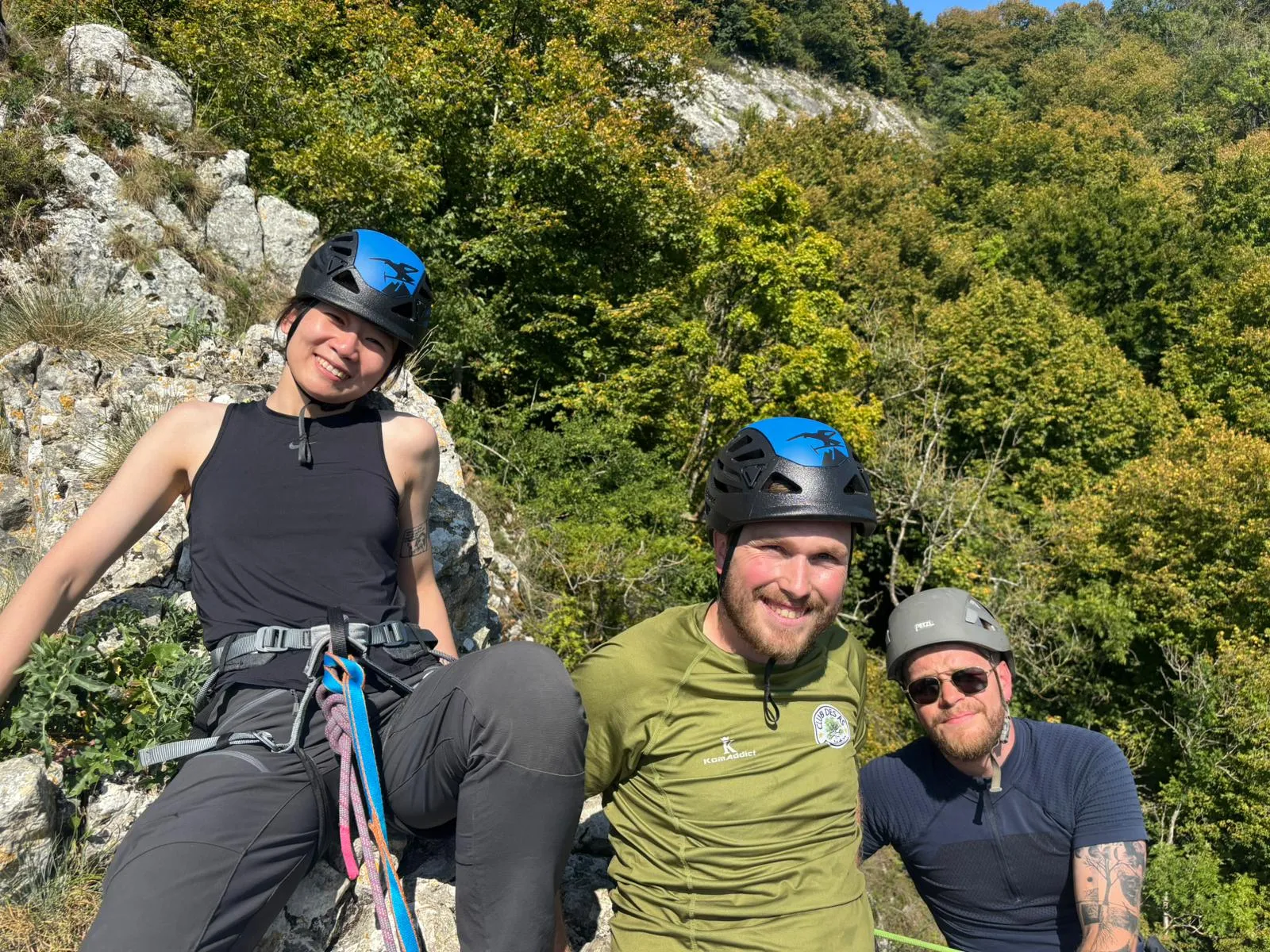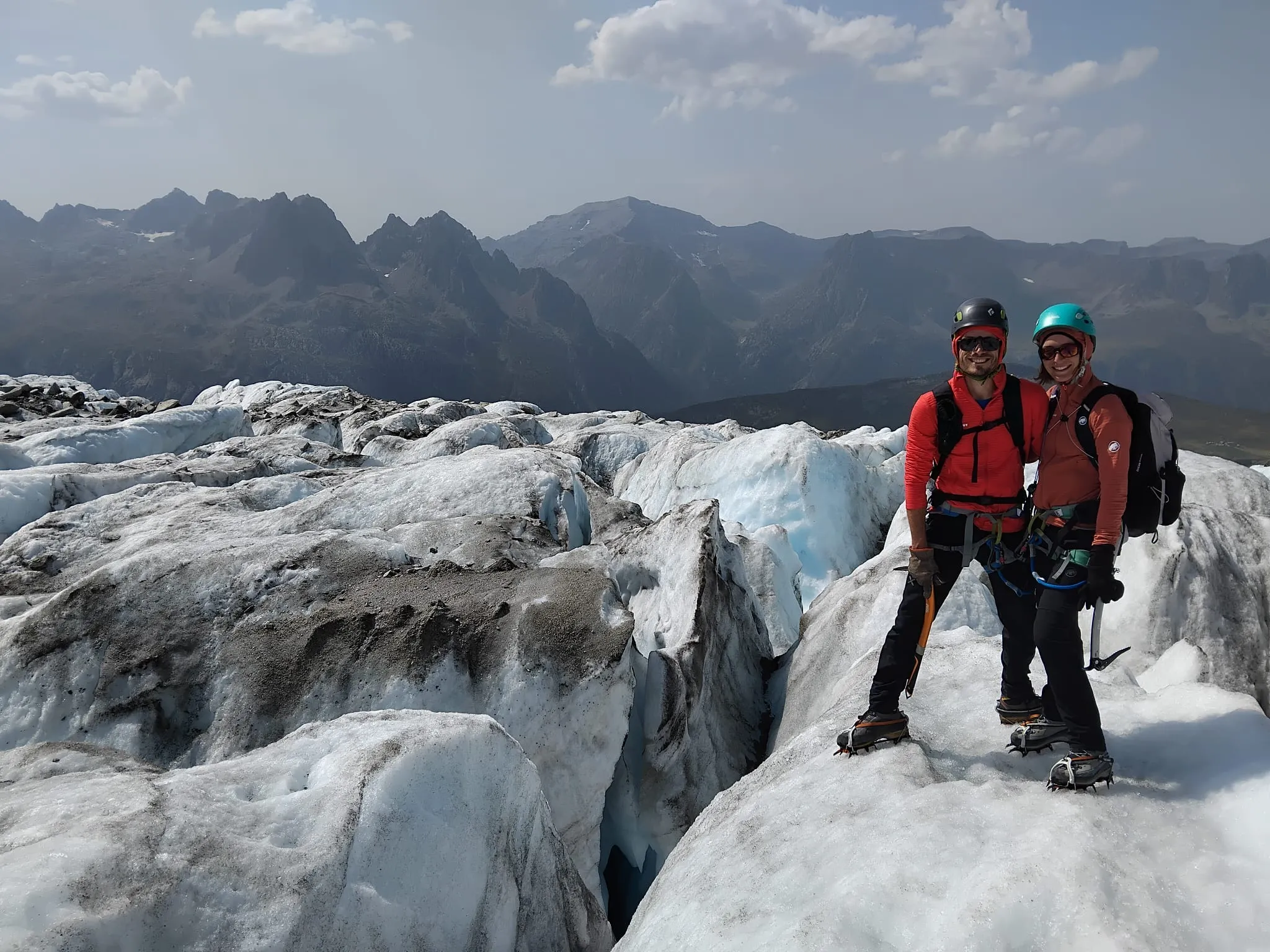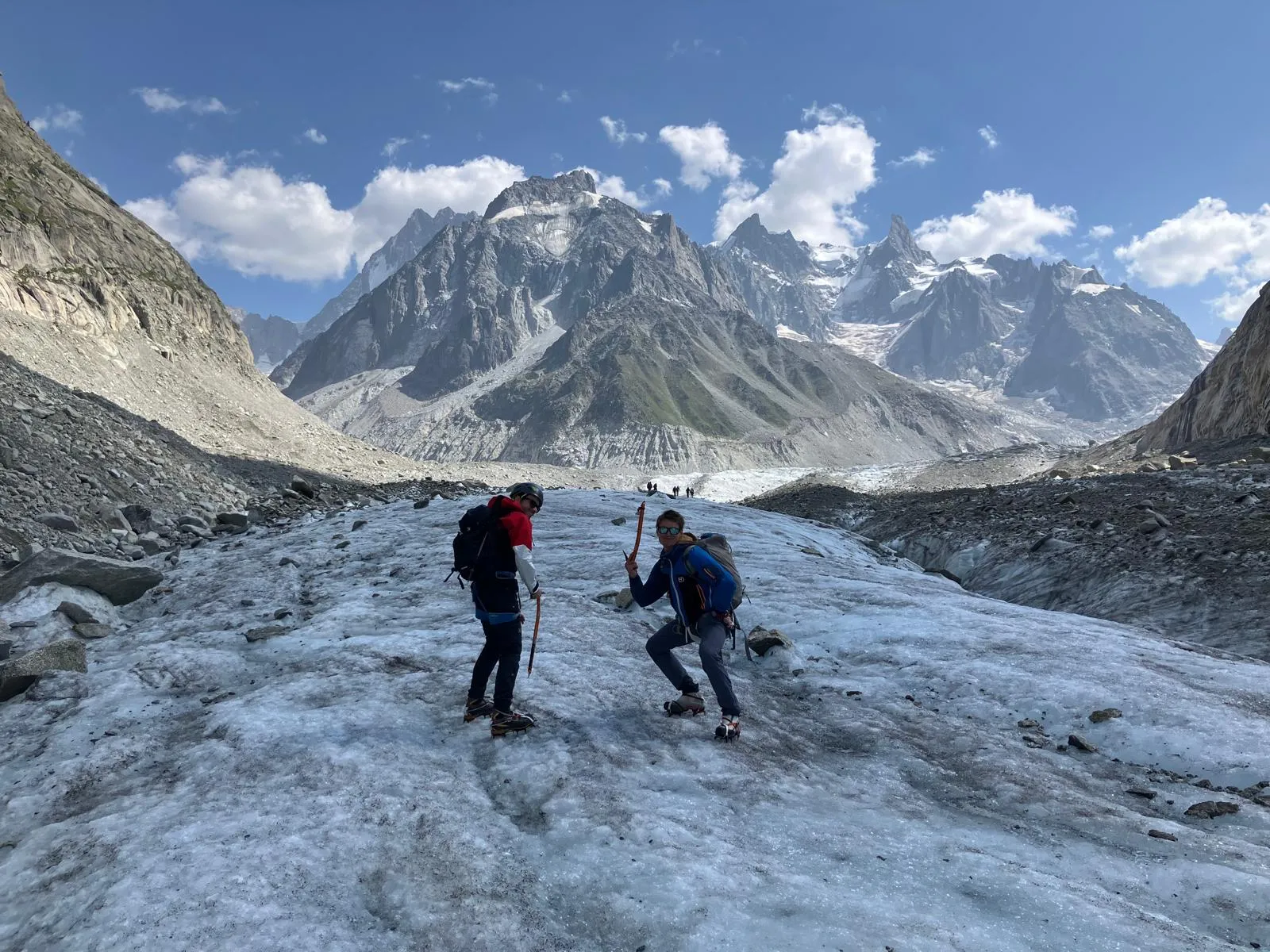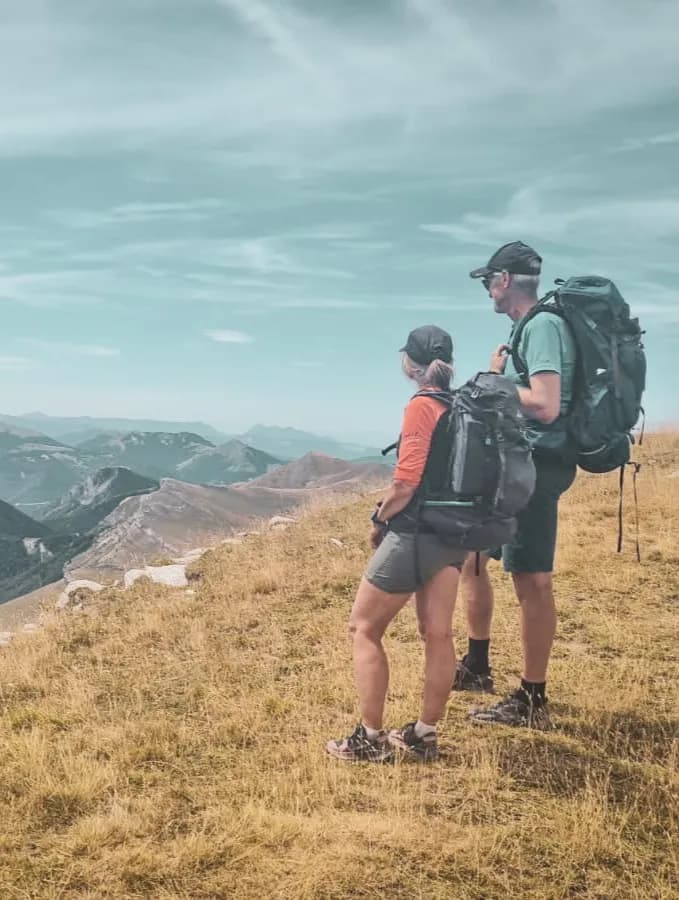mountaineering course: start your adventure in complete safety
Find out how to start mountaineering and choose the ideal mountaineering course. Advice, equipment and training to make your first summits a success.

Taking a mountaineering course is an effective way of gaining your first experience of the mountains in complete safety. Guided by professionals, you progress at your own pace on carefully selected routes. The environment is reassuring, which allays many initial concerns. One of the main advantages of starting with a course is the direct transmission of knowledge. The guides share tried and tested methods for reading the terrain, equipping effectively and reacting to the unexpected.
All the learning takes place in real-life situations, which speeds up progress. The group aspect also enriches the experience: moving forward as a group, sharing the same objectives and experiencing the effort together creates a motivating dynamic, while encouraging individual responsibility and mutual support. Wildhartt offers this type of course, with personalised support and constant attention to safety - essential elements for getting off to a good start. Taking part in a course is a reassuring and accessible entry point to mountaineering for anyone who is motivated.
Who should attend a mountaineering course?
The mountaineering course is aimed at a wide variety of profiles, making it an accessible gateway to all those who want to discover the high mountains in complete safety. Whether you're a complete novice or a sportsman looking to explore new horizons, there's a course format perfectly suited to your needs.
Who can take part in a mountaineering course?
- Beginners: There are no technical prerequisites for most beginner courses. Professional guiding helps you learn the basics step by step.
- Sports enthusiasts looking for a challenge: Anyone who enjoys hiking, trail walking or climbing can enrich their experience with new skills specific to the high mountains.
- Groups or solos: You can sign up as a solo, duo or with friends. Small groups encourage dynamic progress, while ensuring a friendly atmosphere.
The important thing is to be in good general health, to be in a physical condition compatible with walking on rugged terrain and to be willing to learn. Courses often specify the difficulty and level of commitment. Taking the time to read these criteria will help you choose the right experience.
For those who want to immerse themselves in the sport while being guided by experienced guides, Wildhartt offers courses to suit all levels. Their flexible approach makes them easy to access, even for people without an adventure partner or who have never practised before.

How do you choose your first mountaineering course?
Choosing your first mountaineering course requires careful selection, tailored to your expectations and profile. There are a number of criteria to help you make the right choice, to ensure that you learn safely and progressively.
Identify your level and needs
The first step is to be honest about your mountaineering experience. Beginners' courses are aimed at people with no previous mountaineering experience, or even climbing or glacier trekking experience. If you already have some basic mountaineering experience, you should aim for a more suitable advanced course.
Course duration and pace
Most introductory courses last between two and five days, to help you learn the basics gradually. Longer courses encourage continuous practice, but require a high level of physical and mental fitness. Assess your current level of fitness to choose a pace that matches your desire for discovery.
Professional guiding and safety
Take the time to check the guiding staff: a qualified guide, a member of the UIAGM or the Syndicat National des Guides de Montagne, ensures optimum conditions. Their experience in the field structures the group's progress and prevents incidents.
Choice of location and season
The French Alps, Italy, Switzerland and Spain offer varied panoramas and courses available all year round, depending on the weather and altitude. Favouring spring and summer for discovery avoids the harshness of winter conditions reserved for the more experienced.
- Read the feedback or opinions of other trainees
- Contact the organisers to ask specific questions about the programme.
- Pay attention to the size of the group, to guarantee personalised attention
Wildhartt adapts the choice of its courses according to these criteria to facilitate selection and guidance, with the emphasis on safety, quality of guiding and respect for each person's level.

What can you expect to learn on a mountaineering course?
A mountaineering course gives you a unique opportunity to learn essential skills directly from professionals in the field. This learning covers the technical basics as well as safety principles, risk management and self-sufficiency in the mountains.
Reading the terrain and making decisions
Understanding the mountains starts with knowing how to read the environment: analysing slopes, spotting footprints, identifying natural hazards (avalanches, crevasses, rockfalls). These skills improve your ability to anticipate and choose the best route.
Techniques for progressing at high altitude
The first outings include learning how to progress on snow, ice and rock. On the programme: walking with crampons, using an ice axe, roped movement, and progressing on ridges or steep slopes. The aim is to learn how to move forward safely, even on unpredictable terrain.
Safety and equipment management
Using the right equipment and mastering rope techniques are inseparable from mountaineering. On this course, you'll learn how to choose, use and maintain your equipment (harness, helmet, karabiners, pins, etc.), tie the main knots and ensure safe progress as part of a roped party.
- Mastering rope handling (belaying, belaying, crevasse rescue)
- Know when and how to use each piece of equipment
- Reacting effectively in an emergency situation
Finally, special attention is paid to risk management: organising movements, communication within the group, continuous assessment of potential dangers. This knowledge makes each member more autonomous and responsible.
Wildhartt's courses incorporate all these key points in small groups, to guarantee optimum learning conditions in an exceptional and friendly environment.
Essential equipment for beginner mountaineering
Getting into mountaineering means getting the right equipment. Choosing the right equipment is crucial for safety, comfort and the ability to learn during the first course. You don't have to buy everything outright, as some items are often loaned or hired by the guiding team, as is the case at Wildhartt, which avoids a large initial investment.
Basic equipment to get you started
- Mountain boots: Opt for cramponable models that are compatible with the high mountains. Good support protects the ankle on uneven terrain.
- Technical clothing: Multiply the layers (breathable T-shirt, fleece, waterproof and windproof jacket, light down jacket). Don't forget suitable trousers and warm gloves.
- Rucksack: 30 to 40 litres, for water, food, extra clothing and safety equipment.
- Category 3 or 4 sunglasses and sun cream: Protect your eyes and skin from the UV rays intensified by the snow and altitude.
- Helmet, harness and climbing harness: Often provided on guided courses, check with the organiser.
- Technical equipment: Ice axes, crampons, carabiners, rope - ask your provider if they are included in the price of the course.
To keep costs down, buy technical clothing on special offer or second-hand, especially for your first experience. Guides can advise on the suitability and selection of equipment depending on the destination and the season. Reliable equipment optimises progress and reduces fatigue in the field.
Finding out in advance about the specific needs of the course means you can avoid forgetting or overdoing things, so you can tackle mountaineering in the best possible conditions without wasting resources.
Preparing your body and mind for mountaineering
Preparing your body and mind properly provides a solid basis for getting the most out of a mountaineering course. Each trip to altitude calls on specific resources and sometimes tests physical and mental stamina. Feeling ready multiplies the chances of enjoying the experience with pleasure and confidence.
Optimising your physical condition before the course
Regular training is just as important as technical expertise. It's not a question of aiming for performance, but of equipping your body with good endurance and a capacity for prolonged effort:
- Long, uneven walks: gradually increase the duration and intensity over varied terrain.
- Muscle strengthening: target the legs (squats, lunges), sheathing and upper body to carry your bag and progress with the equipment.
- Cardio exercises: running, cycling, swimming to improve breathing and recovery.
Preparing your mind and managing fear
The unknown, exposure or emptiness can generate apprehension. Learning to listen to your sensations limits panic and strengthens your reactions to difficulty:
- Breathing techniques to manage stress or the adrenaline rush
- Positive visualisation: imagine your movements, your progress and the success of important stages.
- Shared experience in a group, such as the Wildhartt courses, reduces isolation and encourages moral support.
Anticipate altitude and its effects
Walking at altitude changes your perception of effort. Plan to acclimatise gradually, hydrate regularly and watch out for signs of excessive fatigue. Professional guides suggest strategies and breaks adapted to each individual, making it easier to adapt without unnecessary pressure.
With targeted physical preparation and the use of simple mental tools, mountaineering becomes as rewarding psychologically as it is athletically.

Wildhartt: an authentic, guided mountaineering experience
Making the most of a mountaineering course requires a safe and inspiring environment. Quality supervision guarantees not only learning, but also the pleasure of stress-free progress. That's the spirit behind Wildhartt's guided holidays, which focus on people and the authentic discovery of the great outdoors.
Qualified guides to help you progress
All Wildhartt holidays are guided by certified mountain guides. These professionals share their in-depth knowledge of the terrain, passing on safe techniques and adapting progress according to the level of the group. Their constant presence creates a reassuring environment, conducive to discussion, teaching and individual follow-up.
A personalised experience
Our small groups mean that we can provide tailor-made support: the guides take the time to listen, answer questions and adjust the objectives according to expectations or any difficulties that may arise. Each participant benefits from personalised feedback as they progress, accelerating learning and boosting self-confidence.
Sustainable commitments in the mountains
Wildhartt pays particular attention to the environmental impact of its activities. The routes are chosen to enhance the natural heritage while limiting the pressure on fragile ecosystems. The organisation also encourages respectful practices: sorting waste, raising awareness of the need to respect the local flora and fauna, sensible use of collective equipment. Discover Wildhartt's sustainable approach to responsible expeditions.
Joining a Wildhartt course is a combination of demanding mountain discovery, sustained learning and a real connection with nature. Our rigorous guiding gives you confidence, while our sustainable approach invites you to explore Europe's mountain ranges in a responsible and friendly way.
Practical advice and mistakes to avoid on your first course
Mountaineering requires preparation, concentration and practical sense to turn your first course into a positive experience. A few practical recommendations will increase your safety and enjoyment throughout the adventure.
Adopt the right safety reflexes
- Always listen to the guide's instructions and ask questions if anything seems unclear
- Inspect your equipment before each outing: harness, helmet, karabiners and knots should all be checked.
- Stay hydrated and eat regularly to avoid fatigue or hypoglycaemia
- Never play down an unusual sensation (cold, tiredness, dizziness): report it immediately to the group or the guide
Avoid the classic pitfalls
- Underestimating the weather: conditions at altitude change rapidly, so always adapt your equipment and be prepared to turn back
- Overestimating your fitness: keep to a pace that respects your limits, even if the group is going faster.
- Forget to acclimatise: plan to arrive in the region the day before to adapt to the mountains gently.
Manage your effort and make lasting progress
- Break up your effort over several days, taking frequent breaks and adjusting the weight of your rucksack.
- Pay close attention to the guide's personal advice to correct your posture and improve your technique as the days go by
- Take the time to recuperate each evening: stretching, hydration and a suitable diet will help you get through the stages more quickly.
Taking part in a course organised by specialist professionals like Wildhartt not only guarantees a safe environment, but also encourages you to progress at your own pace in a friendly group. Following this advice from the very first experience opens the way to more autonomous and even more rewarding practices later on.
The most beautiful destinations for a mountaineering course in Europe
The choice of destination often marks the experience of a first mountaineering course. Each European mountain range offers its own unique atmosphere, spectacular scenery and routes suitable for beginners. Here is a selection of places where you can learn about the high mountains, enjoying unforgettable panoramas and organised so that you can learn in complete safety.
The French Alps: the reference for beginners
The Northern Alps have it all: accessibility, a variety of glacier itineraries and high-performance facilities. Chamonix, with the Mont-Blanc massif, remains a classic base. There are :
- Renowned mountaineering schools
- Comfortable mountain huts within easy walking distance
- A wide range of easy routes, including the Vallée Blanche traverse and the Petit Mont Blanc ascent
The Écrins, less popular but just as suitable, offer a wilder atmosphere and training routes such as the Barre des Écrins to help you understand how to climb at altitude without undue pressure.
Switzerland: grandiose formations and landscapes
In the Valais, Saas-Fee and Zermatt offer beginners the chance to practice on glaciers and learn the basics close to iconic peaks. The Swiss stand out for the quality of their guiding and infrastructure:
- Numerous ski lifts for easy access
- Massifs such as the Mischabels and Weissmies for a gentle first experience
The safety and care given to learning make these destinations particularly reassuring for step-by-step progress.
Italy: Dolomites and a welcoming atmosphere
The very different setting of the Dolomites offers the opportunity to alternate glacier and rock mountaineering, with mixed formations depending on the season. The south of the Monte Rosa massif and the Gran Paradiso allow you to aim for your first 4,000 metres on your own. You'll be immersed in a deep-rooted mountain culture and an organisation that encourages conviviality among beginner groups.
Spain: Pyrenees and Sierra Nevada
For those looking for a sunny start, the Pyrenees (Gavarnie, Ordesa national park) remain a safe alternative with fewer crowds. In Spain, the Sierra Nevada offers a different alpine experience, based more on glacier hiking and accessible peaks, ideal for acclimatising before aiming higher.
Tips for choosing your destination
- Choose areas where guiding is readily available
- Avoid overly technical sites for first-time climbers
- Choose regions that limit the need for long logistical journeys right from the start of the course
Guided holidays like those offered by Wildhartt choose the most beautiful mountain ranges in each country, with itineraries designed to combine immersion, access and safety. This selection means that you can enjoy the scenery without worrying about organisational complexities, while focusing on learning. If you're looking for an introduction to mountaineering, Europe is full of destinations capable of making a lasting impression on every participant.
These adventures might interest you ...

Stevenson’s trail: hike with a Donkey through the Cévennes

Hut-to-hut trekking around Monte Viso

Hiking in Mullerthal: Luxembourg's little Switzerland

Hike the Ecrins with a Donkey by your Side

The king's trail: hiking through Swedish Lapland
